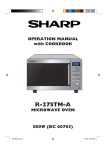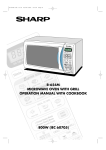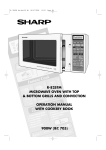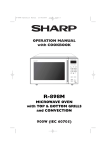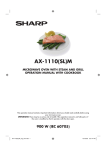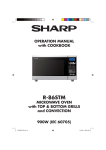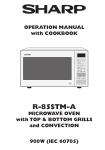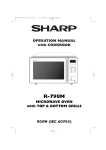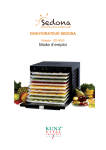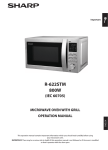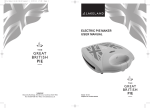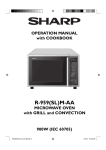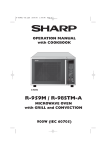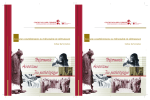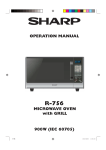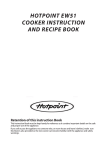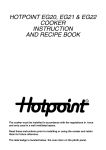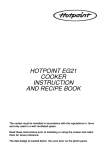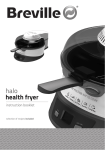Download Sharp R-259 Specifications
Transcript
UK R-259 O/M,-P28 05.3.29 0:03 PM Page A (1,1) OPERATION MANUAL with COOKBOOK R-259 MICROWAVE OVEN 800W (IEC 60705) UK R-259 O/M,-P28 05.3.24 4:15 PM Page B (1,1) OPERATION MANUAL This operation manual contains important information which you should read carefully before using your microwave oven. IMPORTANT: There may be a serious risk to health if this operation manual is not followed or if the oven is modified so that it operates with the door open. If you require any advice or assistance regarding your Sharp product, please visit our website: http://www.sharp.co.uk/support Customers without Internet access may telephone (during office hours): 08705 274277 or from Ireland (01) 676 0648 A. Information on Disposal for Users (private households) Attention: Your product is marked with this symbol. It means that used electrical and electronic products should not be mixed with general household waste. There is a separate collection system for these products. 1. In the European Union Attention: If you want to dispose of this equipment, please do not use the ordinary dust bin! Used electrical and electronic equipment must be treated separately and in accordance with legislation that requires proper treatment, recovery and recycling of used electrical and electronic equipment. Following the implementation by member states, private households within the EU states may return their used electrical and electronic equipment to designated collection facilities free of charge*. In some countries* your local retailer may also take back your old product free of charge if you purchase a similar new one. *) Please contact your local authority for further details. If your used electrical or electronic equipment has batteries or accumulators, please dispose of these separately beforehand according to local requirements. By disposing of this product correctly you will help ensure that the waste undergoes the necessary treatment, recovery and recycling and thus prevent potential negative effects on the environment and human health which could otherwise arise due to inappropriate waste handling. 2. In other Countries outside the EU If you wish to discard this product, please contact your local authorities and ask for the correct method of disposal. For Switzerland: Used electrical or electronic equipment can be returned free of charge to the dealer, even if you don’t purchase a new product. Further collection facilities are listed on the homepage of www.swico.ch or www.sens.ch. B. Information on Disposal for Business Users 1. In the European Union If the product is used for business purposes and you want to discard it: Please contact your SHARP dealer who will inform you about the take-back of the product. You might be charged for the costs arising from take-back and recycling. Small products (and small amounts) might be taken back by your local collection facilities. For Spain: Please contact the established collection system or your local authority for takeback of your used products. 2. In other Countries outside the EU If you wish to discard of this product, please contact your local authorities and ask for the correct method of disposal. UK R-259 O/M,-P28 05.4.4 5:36 PM Page 1 (1,1) CONTENTS OVEN AND ACCESSORIES . . . . . . . . . . . . . . . . . . . . . . . . . . . . . . . . . . . . . . . . . . . . . . . . . . . . . .2 CONTROL PANEL . . . . . . . . . . . . . . . . . . . . . . . . . . . . . . . . . . . . . . . . . . . . . . . . . . . . . . . . . . . . .3 SAFETY: Installation . . . . . . . . . . . . . . . . . . . . . . . . . . . . . . . . . . . . . . . . . . . . . . . . . . . . . . . . . . . . . . . .4 - 5 Important Safety Instructions . . . . . . . . . . . . . . . . . . . . . . . . . . . . . . . . . . . . . . . . . . . . . . . .5 OPERATION: Maff Heating Category . . . . . . . . . . . . . . . . . . . . . . . . . . . . . . . . . . . . . . . . . . . . . . . . . . . . . .6 How Your Oven Works . . . . . . . . . . . . . . . . . . . . . . . . . . . . . . . . . . . . . . . . . . . . . . . . . . . . .6 Microwave Power Levels . . . . . . . . . . . . . . . . . . . . . . . . . . . . . . . . . . . . . . . . . . . . . . . . . . . .7 Before Operation . . . . . . . . . . . . . . . . . . . . . . . . . . . . . . . . . . . . . . . . . . . . . . . . . . . . . . . . . .8 Setting the Clock . . . . . . . . . . . . . . . . . . . . . . . . . . . . . . . . . . . . . . . . . . . . . . . . . . . . . . . . . .8 How to Operate Your Oven . . . . . . . . . . . . . . . . . . . . . . . . . . . . . . . . . . . . . . . . . . . . . . . . .9 - 10 Express Cook / Express Defrost . . . . . . . . . . . . . . . . . . . . . . . . . . . . . . . . . . . . . . . . . . . . . .11 Express Cook Chart . . . . . . . . . . . . . . . . . . . . . . . . . . . . . . . . . . . . . . . . . . . . . . . . . . . . . . . .12 Express Defrost Chart . . . . . . . . . . . . . . . . . . . . . . . . . . . . . . . . . . . . . . . . . . . . . . . . . . . . . .13 Auto Cook . . . . . . . . . . . . . . . . . . . . . . . . . . . . . . . . . . . . . . . . . . . . . . . . . . . . . . . . . . . . . . .13 Auto Cook Chart . . . . . . . . . . . . . . . . . . . . . . . . . . . . . . . . . . . . . . . . . . . . . . . . . . . . . . . . . .14 Convenient Functions . . . . . . . . . . . . . . . . . . . . . . . . . . . . . . . . . . . . . . . . . . . . . . . . . . . . . . .15 - 17 COOKING ADVICE: Microwave Cooking Advice . . . . . . . . . . . . . . . . . . . . . . . . . . . . . . . . . . . . . . . . . . . . . . . . . .18 - 19 Suitable Cookware . . . . . . . . . . . . . . . . . . . . . . . . . . . . . . . . . . . . . . . . . . . . . . . . . . . . . . . . .20 Defrosting Advice . . . . . . . . . . . . . . . . . . . . . . . . . . . . . . . . . . . . . . . . . . . . . . . . . . . . . . . . . .21 Reheating Advice . . . . . . . . . . . . . . . . . . . . . . . . . . . . . . . . . . . . . . . . . . . . . . . . . . . . . . . . . .22 COOKBOOK . . . . . . . . . . . . . . . . . . . . . . . . . . . . . . . . . . . . . . . . . . . . . . . . . . . . . . . . . . . . . . . . .23 - 35 AFTERCARE: Cleaning and Maintenance . . . . . . . . . . . . . . . . . . . . . . . . . . . . . . . . . . . . . . . . . . . . . . . . . . .36 Troubleshooting . . . . . . . . . . . . . . . . . . . . . . . . . . . . . . . . . . . . . . . . . . . . . . . . . . . . . . . . . . .37 To Replace the Mains Plug . . . . . . . . . . . . . . . . . . . . . . . . . . . . . . . . . . . . . . . . . . . . . . . . . . .38 Calling for Service . . . . . . . . . . . . . . . . . . . . . . . . . . . . . . . . . . . . . . . . . . . . . . . . . . . . . . . . .38 GUARANTEE . . . . . . . . . . . . . . . . . . . . . . . . . . . . . . . . . . . . . . . . . . . . . . . . . . . . . . . . . . . . . . . . .39 SPECIFICATIONS . . . . . . . . . . . . . . . . . . . . . . . . . . . . . . . . . . . . . . . . . . . . . . . . . . . . . . . . . . . . . .40 1 UK R-259 O/M,-P28 05.3.24 4:15 PM Page 2 (1,1) OVEN AND ACCESSORIES 9 3 OVEN: 1. Oven lamp 2. Control panel 1 3. Door opening handle 4. Waveguide cover (DO NOT REMOVE) 2 5. Oven cavity 6. Coupling 7. Door latches 8. Door hinges 9. Door seals and sealing surfaces 10. Power cord 11. Ventilation openings 12. Outer cabinet 8 7 11 6 5 4 12 ACCESSORIES: Check to make sure the following accessories are provided: 13. Turntable 14. Roller stay 10 13 14 • Place the roller stay in the coupling on the oven floor, then place the turntable on to the roller stay, ensuring it is located firmly. • To avoid turntable damage, ensure dishes or containers are lifted clear of the turntable rim when removing them from the oven. NOTES: • The waveguide cover is fragile. Care should be taken when cleaning inside the oven to ensure that it is not damaged. • Always operate the oven with the turntable and roller stay fitted correctly. This promotes thorough, even cooking. A badly fitted turntable may rattle, may not rotate properly and could cause damage to the oven. • The turntable rotates clockwise or anti-clockwise. The rotary direction may change each time you start the oven. This does not affect cooking performance. • When you order accessories, please quote both the PART NAME and MODEL NUMBER to your dealer or SHARP approved service facility. WARNING: The door, outer cabinet, oven cavity, turntable and dishes will become very hot during operation. To prevent burns, always use thick oven gloves. 2 UK R-259 O/M,-P28 05.3.24 4:15 PM Page 3 (1,1) CONTROL PANEL 1 2 3 1. DIGITAL DISPLAY 2. TIME keys 3. EXPRESS COOK keys 4. EXPRESS DEFROST keys 5. LESS/MORE TIME keys 6. POWER LEVEL key 7. START/AUTO MINUTE key 8. STOP/CLEAR key 9. KITCHEN TIMER/CLOCK SET key 10. WEIGHT keys 11. AUTO COOK key 11 4 10 5 9 6 8 7 3 UK R-259 O/M,-P28 05.9.5 11:05 AM Page 4 (1,1) INSTALLATION • • • • • 5. Make sure the power supply cord is undamaged (See “ELECTRICAL CONNECTION” below). Do not allow the power supply cord to run over any hot or sharp surfaces, such as the hot air vent area at the top rear of the oven. WARNING: Inspect the Oven: Check the oven carefully for damage before and regularly after installation. Make sure the door closes properly, that it is not misaligned or warped. Check the hinges and door safety latches are not broken or loose. Ensure the door seal and sealing surfaces are not damaged. If the door or door seals are damaged, the oven must not be operated until it has been repaired by a competent person. Inspect the oven interior and door for dents. IMPORTANT: If any damage is apparent, do not operate the oven in any way, until it has been repaired by a SHARP trained engineer. 6. The socket must be readily accessible so that it can be easily unplugged in an emergency. 7. Do not use the oven outdoors. BUILDING-IN-KIT. No built-in kit is available for this oven. This oven is designed to be used on a countertop only. ELECTRICAL CONNECTION. • Do not allow water to come into contact with the power supply cord or plug. • Insert the plug properly into the socket. • Do not connect other appliances to the same socket using an adaptor plug. • If the power supply cord is damaged, it must be replaced by a Sharp approved service facility or a similarly qualified person to avoid a hazard. • When removing the plug from the socket always grip the plug, never the cord as this may damage the power supply cord and the connections inside the plug. • If the plug fitted to your oven is a rewireable type and in the event of the socket outlet in your home not being compatible with the plug supplied, remove the plug properly (do not cut off). • If the plug fitted to your oven is a nonrewirable type and in the event of the socket outlet in your home not being compatible with the plug supplied, cut-off the mains plug. • Refit with a suitable type, observing the wiring code given in `To replace the mains plug’ on page 38. 1. Remove all packing materials including the feature sticker (if applicable). Do not remove the plastic film from the inside of the oven window as this protects it from dirt. The waveguide cover prevents food and grease from entering the waveguide area where it could cause damage. DO NOT REMOVE THE WAVEGUIDE COVER. 2. Place oven on a secure, level surface. Ensure it is strong enough to take the oven weight, plus the heaviest item likely to be cooked in the oven. 3. The minimum height of free space necessary above the top surface of the oven is 15cm. 15cm 4. Do not place the oven where heat, moisture or high humidity are generated, (for example, near or above a conventional oven) or near combustible materials (for example, curtains). Do not block or obstruct air vent openings. Do not place objects on top of the oven. 4 UK R-259 O/M,-P28 08.4.11 2:24 PM Page 5 (1,1) INSTALLATION IMPORTANT! • The fuse from the cut-off plug should be removed and the plug disposed of in a safe manner. • Under no circumstances should the cut-off plug be inserted into a socket outlet as a serious electric shock may occur. • The plug must not be used without the fuse cover fitted. • If you have any doubt about your microwave oven obtain the help of a qualified electrician. • When replacing the plug please ensure that you use a BSI or ASTA approved plug to BS1363, this should be fitted with a brown coloured 13 amp fuse approved by BSI or ASTA to BS1362. If you have any doubt about electrical connection seek the help of a qualified electrician. WARNING: THIS APPLIANCE MUST BE EARTHED To wire an appropriate plug, follow the wiring code given in `To replace the mains plug’ on page 38. IMPORTANT SAFETY INSTRUCTIONS PLEASE READ CAREFULLY AND KEEP FOR FUTURE REFERENCE Oven Use: • The oven is for domestic food use only. • Never operate the oven when empty. • Do not leave or store anything inside the oven when not in use. • Never attempt to use the oven with the door open. It is important not to force or tamper with the door safety latches. • Never operate the oven with any object caught in the door. • Do not insert fingers or objects in the holes of the door latches or air-vent openings as this may damage the oven and cause an electric shock. • If water or food drops inside the air vent openings switch off the oven immediately, unplug it and call a SHARP approved service facility. (See page 38). • Never move the oven while it is operating. WARNING: Only allow children to use the oven without supervision when adequate instructions have been given so that the child is able to use the oven in a safe way and understands the hazards of improper use. This appliance is not intended for use by persons (including children) with reduced physical, sensory or mental capabilities, or lack of experience and knowledge, unless they have been given supervision or instruction concerning use of the appliance by a person responsible for their safety. Children should be supervised to ensure that they do not play with the appliance. WARNING: Liquids and other foods must not be heated in sealed containers since they are liable to explode. Microwave heating of beverages can result in delayed eruptive boiling, therefore care has to be taken when handling the container. Stir the liquid prior to and during heating/ reheating, let liquid stand for at least 20 seconds in the oven after cooking. Pacemaker: If you have a heart pacemaker, consult your doctor or the pacemaker manufacturer prior to oven use. FIRE: If smoke is observed, switch off and unplug the appliance and keep the door closed in order to stifle any flames. 5 UK R-259 O/M,-P28 05.3.24 4:15 PM Page 6 (1,1) MAFF HEATING CATEGORY Microwave output power in Watts (based on international (IEC 60705) standard). Letter representing the oven heating category. The heating category (a letter A to E) developed by MAFF (Ministry of Agriculture, Fisheries and Food) with microwave oven and food manufacturers indicates the ability of the oven to heat small quantities of food (up to 500g [1lb 2oz]). It does not represent the general performance of the oven. Microwave Symbol. OVEN OUTPUT POWER OVEN OUTPUT CATEGORY Food packs carry cooking instructions for heating categories A to E. Follow instructions for the letter corresponding to the oven’s heating category. The higher the output power and heating category of the oven the less heating time is required as shown opposite. Less heating time required 600 700 800 900 1000 Watts More heating time required Less heating time required A B C D E More heating time required HOW YOUR OVEN WORKS Microwaves will pass through certain materials, such as glass and plastic, to heat the food. (See “Suitable Cookware” on page 20). Microwaves are energy waves, similar to those used for TV and radio signals. Electrical energy is converted into microwave energy, which is directed into the oven cavity via a waveguide. To prevent food and grease entering the wave guide it is protected by the waveguide cover. Water, sugar and fat in food absorb microwaves which cause them to vibrate. This creates heat by friction, in the same way your hands get warm when you rub them together. Microwaves cannot pass through metal, because of this the oven cavity is made of metal and there is a fine metal mesh on the door. During cooking the microwaves bounce off the sides of the oven cavity at random. The outer areas of the food are heated by the microwave energy, then the heat moves to the centre by conduction, as it does in conventional cooking. It is important to turn, rearrange or stir food to ensure even heating. Once cooking is complete, the oven automatically stops producing microwaves. Standing time is necessary after cooking, as it enables the heat to disperse equally throughout the food. 6 UK R-259 O/M,-P28 05.3.24 4:15 PM Page 7 (1,1) MICROWAVE POWER LEVELS Power Level Press the POWER LEVEL key Percentage HIGH x1 100P MEDIUM HIGH x2 70P MEDIUM x3 50P MEDIUM LOW (Defrost) x4 30P LOW (Defrost) x5 10P • Your oven has 5 power levels, as shown. • To change the power level for cooking, enter the required time and then press the POWER LEVEL key until the display indicates the desired level. • Power level The microwave power level is varied by the microwave energy switching on and off. When using power levels other than 100P you will be able to hear the microwave energy pulsing on and off as the food cooks or defrosts. IMPORTANT: The microwave power level will default to 100P unless you press the POWER LEVEL key. • For use of the power levels, please refer to the cooking charts and recipes on pages 24 - 35. • Check the power level To check the microwave power level during cooking, press the POWER LEVEL key. As long as your finger is pressing the POWER LEVEL key the power level will be displayed. The oven continues to count down although the display will show the power level. Generally the following recommendations apply: 50P - (MEDIUM output = 400W) for dense foods which require a long cooking time when cooked conventionally, eg. beef casserole, it is advisable to use this power setting to ensure the meat will be tender. 100P - (HIGH output = 800W) used for fast cooking or reheating e.g. for casseroles, hot beverages, vegetables etc. 30P - (MEDIUM LOW output = 240W Defrost setting) to defrost, select this power setting, to ensure that the dish defrosts evenly. This setting is also ideal for simmering rice, pasta, dumplings and cooking egg custard. 70P - (MEDIUM HIGH output = 560W) used for longer cooking of dense foods such as roast joints, meat loaf and plated meals, also for sensitive dishes such as sponge cakes. At this reduced setting, the food will cook evenly without over cooking at the sides. 10P - (LOW output = 80W) For gentle defrosting, eg. cream gateaux or pastry. 7 UK R-259 O/M,-P28 05.3.24 4:15 PM Page 8 (1,1) BEFORE OPERATION Plug in the oven. 1. 1. The oven display will flash: 2. Press the STOP/CLEAR key. 2. 3. The display will show: x1 To set the clock, see below. 3. SETTING THE CLOCK Your oven has a 12 hour and a 24 hour clock. • To select the 12 hour clock, press the KITCHEN TIMER/CLOCK SET key once. will appear on the display. x1 • To select the 24 hour clock, press the KITCHEN TIMER/CLOCK SET key twice. will appear on the display. x2 To set the time of day follow the instructions below: 1. Select the clock type required. 3. Press the KITCHEN TIMER/CLOCK SET key once. 2. Enter the hours by pressing the TIME keys. x1 4. Enter the minutes by pressing the TIME keys. 5. To start the clock, press the KITCHEN TIMER/CLOCK SET key once. x1 NOTES: • Press the STOP/CLEAR key if you make a mistake during programming. • If you press any of the TIME keys too many times, continue to press the key until the desired time re-appears. • To check the time of day during a cooking process, press the KITCHEN TIMER/CLOCK SET key and the time of day will remain on the display as long as you keep your finger on the key. This does not affect the cooking process. • If the clock is set, when cooking is complete, the display will show the correct time of day. If the clock has not been set, the display will only show when cooking is complete. • If the electrical power supply to your microwave oven is interrupted, the display will intermittently show after the power is reinstated. If this occurs during cooking, the programme will be erased. The time of day will also be erased. • When you want to reset the time of day, follow the above example again. 8 UK R-259 O/M,-P28 05.3.24 4:15 PM Page 9 (1,1) HOW TO OPERATE YOUR OVEN Opening the door: To open the oven door, pull the door opening handle. Starting the oven: Prepare and place food in a suitable container onto the turntable or place directly onto the turntable. Close the door and press the START/AUTO MINUTE key. Stopping the oven: If you want to stop the oven during cooking press the STOP/CLEAR key once or open the oven door. If you want to cancel the cooking programme, press the STOP/CLEAR key twice. Manual cooking and defrosting allows you to cook/defrost foods and weights which are not included in the automatic programmes. Following are examples of manual cooking and defrosting. For automatic cooking and defrosting refer to pages 11 - 14. Your oven enables you to cook and defrost food using the automatic programmes, or to cook and defrost food manually. Automatic cooking and defrosting allows you to cook and defrost using preset programmes where the timings have been calculated for you, e.g Express Cook, Express Defrost and Auto Cook. MANUAL COOKING • Enter the cooking time and use microwave power levels 10P to 100P to cook (refer to page 7). • Stir or turn the food, where possible, 2 - 3 times during cooking. • After cooking, cover the food and leave to stand, where recommended. • Refer to the cooking charts in the cookbook section, pages 25 - 28. Example: To cook for 2 minutes and 30 seconds on 70P microwave power. 1. Enter the cooking time by pressing the 1 MIN key twice and then the 10 SEC key 3 times. x2 2. Input the power level by pressing the POWER LEVEL key twice for 70P. x3 x2 3. Press the START/AUTO MINUTE key once to start cooking. x1 The display will count down through the set cooking time. 9 UK R-259 O/M,-P28 05.3.24 4:15 PM Page 10 (1,1) HOW TO OPERATE YOUR OVEN MANUAL DEFROSTING • Enter the defrosting time and use microwave power levels 10P or 30P to defrost (refer to page 7). • Stir or turn the food, where possible, 2 - 3 times during defrosting. • After defrosting, cover the food in foil and leave to stand until thoroughly defrosted. • Refer to the defrosting chart in the cookbook section, page 24. Example: To defrost for 10 minutes on 30P microwave power. 1. Enter the defrosting time by pressing the 10 MIN. key once. 2. Input the power level by pressing the POWER LEVEL key 4 times. x1 x4 3. Press the START/AUTO MINUTE key once to start defrosting. x1 The display will count down through the cooking time. NOTES: • When the oven starts, the oven lamp will light and the turntable will rotate clockwise or anticlockwise. • Your oven can be programmed up to 99 minutes, 90 seconds (99.90). • When the door is opened during cooking, the cooking time on the display stops automatically. The cooking time starts to count down again when the door is closed and the START/AUTO MINUTE key is pressed. • When oven operation has finished, the time of day will reappear on the display, if the clock has been set. • If you wish to know the power level during cooking, press the POWER LEVEL key. As long as your finger is touching the key the power level will be displayed. 10 UK R-259 O/M,-P28 05.3.24 4:15 PM Page 11 (1,1) EXPRESS COOK / EXPRESS DEFROST EXPRESS COOK/EXPRESS DEFROST enables you to cook or defrost the foods listed on the control panel and the charts on pages 12-13. Follow the example below for details on how to operate these functions. EXPRESS COOK allows you to cook 3 popular menus from frozen or chilled. When cooking from frozen (-18°C) press the desired menu key once, display. will appear on the When cooking from chilled (5°C) press the desired menu key twice, display. will appear on the Example 1: To cook medium Roast Beef weighing 1.2kg from chilled using EXPRESS COOK. 1. Press the ROAST BEEF/ LAMB key twice to select cooking from chilled. 2. Enter the weight by pressing the WEIGHT keys until the desired weight is displayed. 3. Press the START/AUTO MINUTE key once to start cooking. OR x2 x4 x1 x8 The display will count down through the cooking time. Example 2: To defrost a Meat Joint weighing 1.2kg using EXPRESS DEFROST. 1. Select the menu required by pressing the MEAT JOINT key once. 2. Enter the weight by pressing the WEIGHT keys until the desired weight is displayed. 3. Press the START/AUTO MINUTE key once to start defrosting. OR x1 x4 x8 x1 The display will count down through the defrosting time. NOTE: If the DOWN (▼) weight key is pressed the display will count down from the highest weight range, each time the key is pressed. If the UP (▲) weight key is pressed the display will count up from the lowest weight range, each time the key is pressed. You can enter the weight by holding down the WEIGHT keys, as well as by pressing, until the desired weight appears. 11 UK R-259 O/M,-P28 05.3.24 4:15 PM Page 12 (1,1) EXPRESS COOK CHART WEIGHT RANGE: • Food weight should be rounded up or down to the nearest 0.1kg, for example, 0.65kg to 0.7kg or 0.34kg to 0.3kg. • You are restricted to enter a weight within the range (see the following charts). • To cook/defrost weights above or below that range or foods not included in the charts below, refer to the charts in the Cookbook section. NOTES: • Press the MORE or LESS TIME keys before pressing the START/AUTO MINUTE key where recommended in the charts below. • When action is required (example, to turn food over), the oven stops, the audible signals sound, the remaining cooking time and an indicator will flash on the display. To continue cooking, press the START/AUTO MINUTE key. • The final temperature will vary according to the initial food temperature. Check food is piping hot after cooking. If necessary, you can extend the cooking manually. • When freezing foods for Express Cook, ensure food is fresh and of good quality. EXPRESS COOK MENU WEIGHT RANGE COOKING PROCEDURE Roast Beef/Lamb 0.5kg - 1.5kg • Place meat in a flan dish on the turntable. • Turn meat over when the audible signal sounds. • After cooking, leave meat to stand wrapped in aluminium foil for 10 minutes. NOTE: Select MORE for well done. It is not possible to use the LESS function for beef/lamb. 0.5kg - 1.5kg • Place meat in a flan dish on the turntable. • Turn meat over when the audible signal sounds. • After cooking, leave meat to stand wrapped in aluminium foil for 10 minutes. NOTE: It is not possible to use the LESS function for pork. 1.2kg - 1.6kg • Pierce skin (chilled only) a few times and place poultry breast side down in a flan dish on the turntable. • Turn poultry over when the audible signal sounds. When cooking frozen poultry with giblets, remove the giblets at first or second turn over. • After cooking, leave poultry to stand wrapped in aluminium foil for 10 minutes. NOTE: It is not possible to use the LESS function for poultry. This menu is only suitable for cooking whole poultry. x1: Frozen x2: Chilled Roast Pork x1: Frozen x2: Chilled Roast Poultry x1: Frozen x2: Chilled 12 UK R-259 O/M,-P28 05.3.24 4:15 PM Page 13 (1,1) EXPRESS DEFROST CHART EXPRESS DEFROST MENU WEIGHT RANGE COOKING PROCEDURE Meat joint: Beef/Lamb/Pork 0.5kg - 1.5kg • Place meat in a flan dish on the turntable. • Turn over when audible signal sounds. • Stand, wrapped in foil, for 60-90 minutes until defrosted. Whole Poultry 1.2kg - 1.6kg • Place poultry breast side up in a flan dish on the turntable. • Turn over when audible signal sounds. • Stand, wrapped in foil, for 60-90 minutes until evenly defrosted. Chicken Quarters 0.4kg - 1.2kg • Place quarters best side up in a flan dish on the turntable. • Turn over and rearrange when audible signal sounds. • Stand, wrapped in foil, for 15-30 minutes until evenly defrosted. Weigh all meat and poultry prior to defrosting and cooking as the labelled weight is only approximate. Defrost: If necessary, shield small areas of meat or poultry with flat pieces of aluminium foil. This will prevent the areas from becoming warm during defrosting. Ensure the foil does not touch the oven walls. Do not cook the meat or poultry until thoroughly defrosted. AUTO COOK AUTO COOK enables you to cook foods listed on the control panel and the chart on page 14. Follow the example below for details on how to operate this function. Example: To cook 0.3kg Rice using Auto Cook AC-2. 1. Select the menu required by pressing the AUTO COOK key twice. 2. Enter the weight by pressing the WEIGHT keys until the desired weight is displayed. 3. Press the START/AUTO MINUTE key to start cooking. OR x2 x1 x3 13 x1 UK R-259 O/M,-P28 05.3.24 4:15 PM Page 14 (1,1) AUTO COOK CHART SELECTING MENU: The menu will be changed automatically by holding down the AUTO COOK key. WEIGHT RANGE: • Food weight should be rounded up or down to the nearest 0.1kg, for example, 0.65kg to 0.7kg or 0.34kg to 0.3kg. • You are restricted to enter a weight within the range given (see the chart below). • To cook weights below or above that range or foods not included in the chart below, refer to the charts in the Cookbook section. NOTES: • If the DOWN (▼) weight key is pressed the display will count down from the highest weight range/ number of pieces, each time the key is pressed. If the UP (▲) weight key is pressed the display will count up from the lowest weight range/number of pieces, each time the key is pressed. • Press the MORE or LESS TIME keys before pressing the START/AUTO MINUTE key where recommended in the chart below. • When action is required (example, to turn food over), the oven stops and the audible signals sound, the remaining cooking time and an indicator will flash on the display. To continue cooking, press the START/AUTO MINUTE key. • The final temperature will vary according to the initial food temperature. Check food is piping hot after cooking. If necessary, you can extend the cooking manually. No MENU WEIGHT RANGE COOKING PROCEDURE AC-1 Jacket Potatoes 1 - 4 pieces (1 potato = approx. 250g) • Pierce each potato in several places and place towards the edge of the turntable. • Turn food over when the oven indicates. • Stand, wrapped in aluminium foil for 5 minutes. AC-2 Rice / Pasta 0.1kg - 0.3kg • Add 300ml (1/2 pint) boiling water per 100g rice/pasta. • Do not cover. • Stir when oven indicates. • Stand for 2 minutes before draining and rinsing in boiling water. AC-3 Fresh Vegetables 0.1kg - 0.4kg • Cut, chop or slice fresh vegetables into even sized pieces. Place fresh vegetables in a suitable container. • Add 15ml (1tbsp) of water per 100g of vegetables, cover dish with cling film and pierce in several places. • Place on the turntable. • Stir when oven indicates. • Stand for 2 - 3 minutes before serving. 14 UK R-259 O/M,-P28 05.3.24 4:15 PM Page 15 (1,1) CONVENIENT FUNCTIONS 1. SEQUENCE COOKING: This function enables continued and uninterrupted operation of up to 3 different stages. Example: To cook for: 5 minutes on 100P power (Stage 1) 16 minutes on 30P power (Stage 2) STAGE 1 1. Enter the cooking time by pressing the 1 MIN key 5 times. 2. Input the power level by pressing the POWER LEVEL key once. x5 x1 STAGE 2 3. Enter the cooking time by pressing the 10 MIN key once and then the 1 MIN key 6 times. x1 4. Input the power level by pressing the POWER LEVEL key 4 times. x6 5. Press the START/ AUTO MINUTE key once to start. x4 x1 The oven will begin to cook for 5 minutes on 100P and then for 16 minutes on 30P. NOTE: If 100P is selected as the final power level, it is not necessary to input the power level. Example: 2. AUTO MINUTE: AUTO MINUTE enables you: • To cook on 100P microwave power in multiples of 1 minute. • To extend cooking time in multiples of 1 minute. You can use this function for manual cooking only. x2 Example: To cook on 100P for 2 minutes, press the START/AUTO MINUTE key twice. NOTE: • The AUTO MINUTE function for direct start, can only be input within 3 minutes after cooking completion, closing the door or pressing the STOP/CLEAR key. • The cooking time may be extended to a maximum of 99 minutes. 15 UK R-259 O/M,-P28 05.3.24 4:15 PM Page 16 (1,1) CONVENIENT FUNCTIONS 3. LESS (▼) and MORE (▲) TIME: The LESS (▼) TIME and MORE (▲) TIME keys enable you to: • Cook/defrost food for less or more time than the automatic programmes. • Decrease or increase cooking/defrosting time whilst the oven is in use (manual cooking only). TO USE LESS AND MORE WITH EXPRESS COOK / EXPRESS DEFROST / AUTO COOK Press the LESS (▼) / MORE (▲) TIME key before pressing the START/AUTO MINUTE key. For Example: If you prefer Jacket Potatoes which are cooked but still firm, use the LESS (▼) TIME key. Alternatively, if you prefer Jacket Potatoes softer, use the MORE (▲) TIME key. If you select MORE, the display will show . Alternatively, if you select LESS, the display will show . Some menus cannot use the LESS function. If you select LESS for them, will appear when the START/ AUTO MINUTE key is pressed. NOTE: To cancel LESS (▼) / MORE (▲), simply press the same key again. To change MORE to LESS simply press the LESS (▼) TIME key. To change LESS to MORE simply press the MORE (▲) TIME key. TO USE LESS AND MORE WITH MANUAL COOKING Press the LESS (▼) or MORE (▲) TIME key to decrease or increase the cooking or defrosting time in multiples of 1 minute whilst the oven is in use. The overall cooking time can be increased to a maximum of 99 minutes. Example: To cook on 50P for 10 minutes and then decrease the cooking time by 2 minutes: 1. Enter the cooking time by pressing the 10 MIN key once. 2. Input the power level by pressing the POWER LEVEL key three times. x3 x1 4. Reduce the cooking time by pressing the LESS TIME key twice. 3. Press the START/AUTO MINUTE key once to start cooking. Cooking time is reduced by 2 minutes and continues to count down, for example: x2 16 x1 UK R-259 O/M,-P28 05.3.24 4:15 PM Page 17 (1,1) CONVENIENT FUNCTIONS 4. KITCHEN TIMER: Use the KITCHEN TIMER as a minute timer or to monitor the standing time for cooked / defrosted food. Example: To set the timer for 5 minutes. 1. Enter the desired time by pressing the 1 MIN key 5 times. x5 2. Press the KITCHEN TIMER/CLOCK SET key once. The display will count down. When the display reaches zero, the audible signal will sound. x1 You can enter any time up to 99 minutes, 90 seconds. To cancel the KITCHEN TIMER whilst counting down, simply press the STOP/CLEAR and the display will return to the time of day, if set. NOTE: The KITCHEN TIMER function cannot be used whilst cooking. 17 UK R-259 O/M,-P28 05.3.24 4:15 PM Page 18 (1,1) MICROWAVE COOKING ADVICE Many of the following techniques are similar to those used in conventional cooking. Microwaves cook food faster than conventional cooking. It is therefore essential that certain techniques are followed to ensure good results. COOKING ADVICE NOTES: • Always attend the oven when in use. • Ensure that the utensils are suitable for use in a microwave oven. (See “Suitable Cookware” on page 20). • Refer to the charts in the cookbook section for recommended cooking times and power levels. • Do not place hot foods/utensils on a cold turntable or cold foods/utensils on a hot turntable. • Liquids and foods must not be heated in sealed containers or jars/containers with lids on, as pressure will build up inside and may cause the container/jar to explode. • Only use microwave popcorn within the recommended packaging (follow the manufacturers instructions). Never use oil unless specified by the manufacturer and never cook for longer than instructed. WARNING: Follow instructions in the SHARP operation manual at all times. If you exceed recommended cooking times and use power levels that are too high, food may overheat, burn and in extreme circumstances, catch fire and damage the oven. Cooking Techniques Arrange Place the thickest parts of food towards the outside of the dish. e.g. Chicken drumsticks. Foods that are placed towards the outside of the dish will receive more energy, so cook quicker, than those in the centre. Cover Certain foods benefit from being covered during microwave cooking, follow recommendations where given. Use vented microwave cling film or a suitable lid. Pierce Foods with a shell, skin or membrane must be pierced in several places before cooking or reheating as steam will build up and may cause food to explode. e.g. Potatoes, Fish, Chicken, Sausages. NOTE: Eggs in their shells and hard / soft boiled eggs should not be heated in the microwave oven as they may explode, even after cooking has ended. Stir, turn and rearrange For even cooking it is essential to stir, turn and rearrange food during cooking. Always stir and rearrange from the outside towards the centre. Stand Standing time is necessary after cooking as it enables the heat to disperse equally throughout the food. 18 UK R-259 O/M,-P28 05.3.24 4:15 PM Page 19 (1,1) MICROWAVE COOKING ADVICE Food Characteristics Composition Foods high in fat or sugar (e.g. Christmas pudding, mince pies) require less heating time. Care should be taken as overheating can lead to fire. Bones in food conduct heat, making the food cook more quickly. Care must be taken so that the food is cooked evenly. Density Food density will affect the amount of cooking time needed. Light, porous foods, such as cakes or bread, cook more quickly than heavy, dense foods, such as roasts and casseroles. Quantity The number of microwaves in your oven remains the same regardless of how much food is being cooked. The cooking time must be increased as the amount of food placed in the oven increases. e.g. Four potatoes will take longer to cook than two. Size Small foods and small pieces cook faster than large ones, as microwaves can penetrate from all sides to the centre. For even cooking make all the pieces the same size. Shape Foods which are irregular in shape, such as chicken breasts or drumsticks, take longer to cook in the thicker parts. For even cooking, place the thickest parts to the outside of the dish where they will receive more energy. Round shapes cook more evenly than square shapes when microwave cooking. Temperature of food The initial temperature of food affects the amount of cooking time needed. Chilled foods will take longer to cook than food at room temperature. e.g. A cake made with chilled ingredients, (i.e. margarine) will take longer to cook than a cake made with ingredients at room temperature. The temperature of the container is not a true indication of the temperature of the food or drink. Cut into foods with fillings, for example jam doughnuts, to release heat or steam. Face & Hands: Always use oven gloves to remove food or cookware from the oven. Stand back when opening the oven door to allow heat or steam to disperse. When removing covers (such as cling film), opening roasting bags or popcorn packaging, direct steam away from face and hands. Check the temperature of food and drink and stir before serving. Take special care when serving to babies, children or the elderly. The contents of feeding bottles and baby food jars are to be stirred or shaken and the temperature is to be checked before consumption to avoid burns. 19 UK R-259 O/M,-P28 05.3.24 4:15 PM Page 20 (1,1) SUITABLE COOKWARE Round/oval dishes are preferable to square/oblong ones, as the food in the corners tends to overcook. A variety of cookware can be used as listed below. To cook/defrost food in a microwave oven, the microwave energy must be able to pass through the container to penetrate the food. Therefore it is important to choose suitable cookware. Cookware Microwave Safe Comments Aluminium foil Foil Containers ✔/✘ Small pieces of aluminium foil can be used to shield food from overheating. Keep foil at least 2cm from the oven walls, as arcing may occur. Foil containers are not recommended unless specified by the manufacturer, e.g. Microfoil ®, follow instructions carefully. Browning dishes ✔ Always follow the manufacturers instructions. Do not exceed heating times given. Be very careful as these dishes become very hot. ✔/✘ Porcelain, pottery, glazed earthenware and bone china are usually suitable, except for those with metallic decoration. Glassware e.g. Pyrex ® ✔ Care should be taken if using fine glassware as it can break or crack if heated suddenly. Metal ✘ It is not recommended to use metal cookware as it will arc, which can lead to fire. Plastic/Polystyrene e.g fast food containers ✔ Care must be taken as some containers warp, melt or discolour at high temperatures. Cling film ✔ It should not touch the food and must be pierced to let the steam escape. Freezer/Roasting bags ✔ Must be pierced to let steam escape. Ensure bags are suitable for microwave use. Do not use plastic or metal ties, as they may melt or catch fire due to the metal ‘arcing’. Paper - Plates, cups and kitchen paper ✔ Only use for warming or to absorb moisture. Care must be taken as overheating may cause fire. Straw and wooden containers ✔ Always attend the oven when using these materials as overheating may cause fire. Recycled paper and newspaper ✘ May contain extracts of metal which will cause ‘arcing’ and may lead to fire. China and ceramics NOTE: When heating food in plastic or paper containers, monitor the oven due to the possibility of ignition. 20 UK R-259 O/M,-P28 05.3.24 4:15 PM Page 21 (1,1) DEFROSTING ADVICE Defrosting food using your microwave oven is the quickest method of all. It is a simple proccess but the following instructions are essential to ensure the food is thoroughly defrosted. Rearrange Foods that are placed towards the outside of the dish will defrost quicker than foods in the centre. It is therefore essential that the food is rearranged up to 4 times during defrosting. Move closely packed pieces from the outside to the centre and rearrange over-lapping areas. This will ensure that all parts of the food defrosts evenly. Separate Foods may be stuck together when removed from the freezer. It is important to separate foods as soon as it is possible during defrosting. e.g. bacon rashers, chicken fillets. Shield Some areas of food being defrosted may become warm. To prevent them becoming warmer and starting to cook, these areas can be shielded with small pieces of foil, which reflect microwaves. e.g. legs and wings on a chicken. Stand Standing time is necessary to ensure food is thoroughly defrosted. Defrosting is not complete once the food is removed from the microwave oven. Food must stand, covered, for a length of time to ensure the centre has completly defrosted. Turn over It is essential that all foods are turned over at least 3 - 4 times during defrosting. This is important to ensure thorough defrosting. NOTES: • Remove all packaging and wrapping before defrosting. • To defrost food, use microwave power levels MEDIUM LOW or LOW. • Please refer to the defrosting chart on page 24 for further information. 21 UK R-259 O/M,-P28 05.3.24 4:15 PM Page 22 (1,1) REHEATING ADVICE For the reheating of foods, follow the advice and guidelines below to ensure food is thoroughly reheated before serving. Plated meals Remove any poultry or meat portions, reheat these separately, see below. Place smaller items of food to the centre of the plate, larger and thicker foods to the edge. Cover with vented microwave cling film and reheat on MEDIUM, stir/ rearrange halfway through reheating. NOTE: Ensure the food is thoroughly reheated before serving. Sliced meat Cover with vented microwave cling film and reheat on MEDIUM. Rearrange at least once to ensure even reheating. NOTE: Ensure the meat is thoroughly reheated before serving. Poultry portions Place thickest parts of the portions to the outside of the dish, cover with vented microwave cling film and reheat on MEDIUM HIGH. Turn over halfway through reheating. NOTE: Ensure the poultry is thoroughly reheated before serving. Casseroles Cover with vented microwave cling film or a suitable lid and reheat on MEDIUM. Stir frequently to ensure even reheating. NOTE: Ensure the food is thoroughly reheated before serving. To achieve the best results when reheating, select a suitable microwave power level appropriate to the type of food. e.g. A bowl of vegetables can be reheated using HIGH, while a lasagne which contains ingredients that cannot be stirred, should be reheated using MEDIUM. NOTES: • Remove food from foil or metal containers before reheating. • Reheating times will be affected by the shape, depth, quantity and temperature of food together with the size, shape and material of the container. Never heat liquids in narrow-necked containers, as this could result in the contents erupting from the container and may cause burns. • To avoid overheating and fire, special care must be taken when reheating foods with a high sugar or fat content, e.g. mince pies or Christmas pudding. • Never heat oil or fat for deep frying as this may lead to overheating and fire. • Canned potatoes should not be heated in the microwave oven, follow the manufacturer's instructions on the can. The contents of feeding bottles and baby food jars are to be stirred or shaken and the temperature is to be checked before consumption to avoid burns. 22 UK R-259 O/M,-P28 05.3.24 4:15 PM Page 23 (1,1) COOKBOOK CONTENTS INTRODUCTION, COOKERY NOTES & CONVERSION CHARTS . . . . . . . . . . . . . . . . . . . . . . . . .23 DEFROSTING CHART: Meat, poultry, fish, fruit, bread, pastry, savoury pie & quiche . . . . . . . . . . . . . . . . . . . . .24 COOKING CHARTS: Meat, poultry & fish . . . . . . . . . . . . . . . . . . . . . . . . . . . . . . . . . . . . . . . . . . . . . . . . . . . . . .25 Fresh & frozen vegetables & fruit . . . . . . . . . . . . . . . . . . . . . . . . . . . . . . . . . . . . . . . . . . . .26 Rice, pasta & eggs . . . . . . . . . . . . . . . . . . . . . . . . . . . . . . . . . . . . . . . . . . . . . . . . . . . . . . . .27 REHEATING CHART . . . . . . . . . . . . . . . . . . . . . . . . . . . . . . . . . . . . . . . . . . . . . . . . . . . . . . . . . . .28 RECIPES . . . . . . . . . . . . . . . . . . . . . . . . . . . . . . . . . . . . . . . . . . . . . . . . . . . . . . . . . . . . . . . . . . . . .28-35 INTRODUCTION This Cookbook contains a wide variety of recipes developed specifically for your microwave oven. These will give you successful results and will save time and electricity. The recipes demonstrate the capabilities of your oven and prove that microwave technology is the efficient and effective alternative to conventional cooking. The cookery notes below compliment all cooking procedures in this cookbook and should be read in advance of recipe preparation. COOKERY NOTES • Please weigh all meat and poultry prior to defrosting and cooking, as labelled weights are only approximate. • Where dishes are covered use vented microwave cling film unless otherwise stated. Where dishes are lined, use greaseproof paper unless otherwise stated. • Please note that all serving quantities are approximate. • Cooking times in the charts and recipes are based on standard conditions. Cooking results will vary according to the condition of foods, utensils and the oven. Please check the cooking result and, if necessary, adjust cooking times accordingly. • Serve all dishes immediately unless otherwise stated. • Half-fat, skimmed or full-fat milk may be used in all recipes, as preferred. • Where it is necessary to blend foods, use a food processor, liquidiser or press through a sieve. • The recipes in this cookery book were developed using chilled eggs and fat. Room temperature ingredients may give a different result. • Chilled foods are to be cooked from 5°C. DO NOT COOK FROM FROZEN. • Ambient/fresh/dried/canned foods are to be cooked from 20°C. DO NOT COOK FROM FROZEN. • Frozen foods are to be cooked from -18°C. CONVERSION CHARTS WEIGHT MEASURES 1/2oz 15g 25g 1oz 50g 2oz 100g 4oz 175g 6oz 225g 8oz 450g 1lb VOLUME MEASURES 30ml 1floz 100ml 3floz 150ml 5floz (1/4 pint) 300ml 10floz (1/2 pint) 600ml 20floz (1 pint) 23 SPOON MEASURES 1/4 teaspoon 1.25ml 1/2 teaspoon 2.5ml 5ml 1 teaspoon 15ml 1 tablespoon UK R-259 O/M,-P28 05.3.24 4:15 PM Page 24 (1,1) DEFROSTING CHART FOOD DEFROST MICRO TIME POWER LEVEL ▼ METHOD ● STANDING TIME Meat Joints (Beef, Lamb, Pork) 16 - 17 Minutes/ 450g 10P Minced Meat 10 - 12 Minutes/ 450g Stage1: 30P Stage 2: 10P Steak/Chops 2cm (3/4”) thick 14 - 15 Minutes/ 450g 10P Place in a flan dish. Turn 2-3 times, separate during defrosting. Shield. 25 - 30 Minutes 6 - 7 Minutes/ 450g 30P Place in a flan dish. Turn 2-3 times, separate during defrosting. Shield. 15 - 20 Minutes Bacon 10 - 12 Minutes/ 450g 10P Beefburgers 12 - 13 Minutes/ 450g 10P Place on a plate. Turn over and separate twice during defrosting. 15 - 20 Minutes ❖ Whole Poultry (Chicken,Turkey,Duck) 19 - 20 Minutes/ 450g 10P Place in a flan dish. Turn 4-5 times, during defrosting. Shield. 60 - 90 Minutes 8 - 9 Minutes/ 450g 30P Place in a flan dish. Turn 2-3 times, separate during defrosting. Shield. 25 - 30 Minutes 10 - 11 Minutes/ 450g 30P Place in a flan dish. Turn 2-3 times, separate during defrosting. Shield. 15 - 30 Minutes Minced Turkey 7 - 8 Minutes/ 450g 30P Place in a bowl. Turn 3-4 times, 15 - 20 Minutes removing defrosted mince each time. Fish (Whole/FIllets/Steaks) 8 - 9 Minutes/ 450g 30P Place in a flan dish. Separate and rearrange twice during defrosting. Shield. Apples/Rhubarb 7 - 8 Minutes/ 450g 30P Place in a dish. Stir during defrosting. 15 - 20 Minutes Shield. 5 Minutes/ 400g 30P Place on the turntable. Separate and 5 - 10 Minutes rearrange during defrosting. 6 - 7 Minutes/ 450g 10P Place on a plate. Turn over half way 10 - 15 Minutes through defrosting. 15 - 16 Minutes/ 500g pie, quiche 10P Remove from foil container. Place in 20 - 30 Minutes a flan dish. 11 - 12 Minutes/ 400g pie 10P Remove from foil container. Place in 20 - 30 Minutes a flan dish. 16 - 17 Minutes/ 700g pie 10P Sausages Chicken Legs Chicken/Turkey Breasts & Fillets Bread (sliced) Pastry (Puff or Shortcrust) Savoury Pie & Quiche (cooked) Place in a flan dish. Turn over 4-5 times during defrosting. Shield. 90 - 120 Minutes Place on a plate. Use sequence programming. Stage 1: Defrost on 30P for the first quarter of cooking time. Stage 2: Defrost on 10P for the remaining cooking time. Turn over 3-4 times, removing defrosted mince each time. 15 - 30 Minutes Place on a plate. Separate and re5 - 10 Minutes arrange twice during defrosting. Shield. 15 Minutes 20 - 21 Minutes/ 800g pie, quiche Fruit Pie ▼ ❖ ● Method: If shielding is necessary, use small pieces of foil. Poultry: Chicken, turkey and duck must be defrosted without giblets. Standing Time: During recommended standing time, wrap or cover food in foil. 24 UK R-259 O/M,-P28 05.3.24 4:15 PM Page 25 (1,1) COOKING CHART FOOD COOKING MICRO TIME POWER LEVEL ▼ METHOD ● STANDING TIME Beefburgers 10 - 11 Minutes/ 450g 70P Place in a flan dish. Turn over halfway through cooking. 2 - 3 Minutes Minced Meat 8 Minutes/ 450g 70P Place in a bowl. Stir 2-3 times during cooking. 2 - 3 Minutes Sausages (thick) 8 - 9 Minutes/ 8 sausages 70P Place in a flan dish. Turn over halfway through cooking. 2 Minutes Sausages (thin) 6 - 7 Minutes 8 sausages 70P Place in a flan dish. Turn over halfway through cooking. 2 Minutes Bacon 3 - 4 Minutes/ 2 - 4 slices 100P Place in a flan dish. Turn over halfway through cooking. 1 Minute 12 - 13 Minutes/ 450g 70P Place in a flan dish. Turn over halfway through cooking. 10 Minutes Chicken/Turkey Portions, 11 - 12 Minutes/ Breasts & Drumsticks 450g 70P Place in a flan dish. Turn over halfway through cooking. 5 Minutes Minced Turkey 9 - 10 Minutes/ 450g 100P Place in a bowl. Stir 3-4 times during cooking. 2 - 3 Minutes Fish Fillets 9 - 10 Minutes/ 450g 70P Place in a flan dish. Cover with cling film. 2 - 3 Minutes Whole fish & Steaks (Trout, Mackerel) 7 - 8 Minutes/ 450g 70P Place in a flan dish. Cover with cling film. 3 - 4 Minutes Whole Poultry: Chicken, Turkey & Duck ▼ ● Method: If shielding is necessary, use small, pieces of foil. Standing Time: During recommended standing time, wrap or cover food in foil. Note: Prior to cooking, food is refrigerated, 50C. 25 UK R-259 O/M,-P28 05.3.24 4:16 PM Page 26 (1,1) COOKING CHART FOOD COOKING MICRO TIME POWER LEVEL ▼ METHOD ● STANDING TIME Aubergines & Broccoli (fresh) 6 Minutes/ 225g 100P Place in dish. Add 30ml (2 tbsp) water. Cover dish. Stir halfway through cooking. 2 Minutes Sliced Beans (green - fresh) 6 Minutes/ 225g 100P Place in dish. Add 30ml (2 tbsp) water. Cover dish. Stir halfway through cooking. 2 Minutes Brussels Sprouts (fresh) 6 Minutes/ 225g 100P Place in dish. Add 45ml (3 tbsp) water. Cover. Stir halfway through cooking. 2 Minutes Cabbage, Carrots, Cauliflower, Celery 6 Minutes/ 225g 100P 2 Minutes Corn on the Cob (fresh) 7 Minutes/ 225g 100P Slice or break into florets. Place in dish. Add 30ml (2 tbsp) water. Cover. Stir halfway through cooking. Place in dish. Add 45ml (3 tbsp) water. Cover. Stir 1/2 through cooking. Sliced Courgettes & Leeks (fresh) 5 Minutes/ 225g 100P Place in dish. Add 30ml (2 tbsp) water. Cover dish. Stir halfway through cooking. 2 Minutes Sliced Parsnips & Spinach (fresh) 6 Minutes/ 225g 100P Place in dish. Add 45ml (3 tbsp) water. Cover. Stir halfway through cooking. 2 Minutes Peas (fresh) 5 Minutes/ 225g 100P Place in dish. Add 30ml (2 tbsp) water. Cover dish. Stir halfway through cooking. 2 Minutes Potatoes, Jacket (250g - each) 12 Minutes/ 2 potatoes 100P Prick in several places. Place in dish. Place on the edge of the turntable. 5 Minutes Potatoes, Boiled (old & new - fresh) 11 Minutes/ 225g 100P 4 Minutes Diced Swede & Turnips (fresh) 8 Minutes/ 225g 100P Cut into quarters. Place in dish. Add 60ml (4 tbsp) water. Cover. Stir halfway through cooking. Place in dish. Add 45ml (3 tbsp) water. Cover dish. Stir halfway through cooking. Beans & Cabbage (green - frozen) 6 Minutes/ 225g 100P Place in dish. Add 15ml (1 tbsp) water. Cover dish. Stir halfway through cooking. 2 Minutes Broccoli, Leaf Spinach /Brussels Sprouts (frozen) 7 Minutes/ 225g 100P Place in dish. Add 15ml (1 tbsp) water. Cover dish. Stir halfway through cooking. 2 Minutes Carrots - sliced (frozen) 7 Minutes/ 225g 100P Place in dish. Add 15ml (1 tbsp) water. Cover dish. Stir halfway through cooking. 3 Minutes Cauliflower florets (frozen) 6 Minutes/ 225g 100P Place in dish. Add 15ml (1 tbsp) water. Cover dish. Stir halfway through cooking. 2 Minutes Corn on the Cob (frozen) 12 Minutes/ 2 cobs 100P Place in dish. Cover dish. Turnover halfway through cooking. 3 Minutes Peas, Sweetcorn & Mixed Vegetables (frozen) 6 Minutes/ 225g 100P Place in dish. Cover dish. Stir halfway through cooking. 2 Minutes Apples & Rhubarb 6 Minutes/ 450g 100P Peel & slice. Place in a dish and cover. Stir during cooking. 2 Minutes Blackberries/Raspberries/Redcurrants 6 Minutes/ 450g 100P Place in a dish and cover. Stir during cooking. 2 Minutes NOTE: • Fresh vegetables and fruit are cooked from 20°C (ambient temperature). • Frozen vegetables are cooked from -18°C. 26 2 Minutes 2 Minutes UK R-259 O/M,-P28 05.3.24 4:16 PM Page 27 (1,1) COOKING CHART FOOD ❇ COOKING MICRO TIME POWER LEVEL ▼ METHOD ● STANDING TIME White rice (long grain) 14 - 15 Minutes 70P Add 300ml (1/2 pint) boiling water/100g rice. Do not cover. Stir twice during cooking. 2 Minutes Brown rice 20 - 21 Minutes 70P Add 400ml (14fl.oz) boiling water/100g rice. Do not cover. Stir twice during cooking. 2 Minutes Spaghetti (short cut) 11 - 12 Minutes 70P Add 300ml (1/2 pint) boiling water/100g pasta. Do not cover. Stir twice during cooking. 2 Minutes Macaroni (short cut) 12 - 13 Minutes 70P Add 300ml (1/2 pint) boiling water/100g pasta. Do not cover. Stir twice during cooking. 2 Minutes Tagliatelle 10 - 11 Minutes 70P Add 300ml (1/2 pint) boiling water/100g pasta. Do not cover. Stir twice during cooking. 2 Minutes Pasta shells 11 - 12 Minutes 70P Add 300ml (1/2 pint) boiling water/100g pasta. Do not cover. Stir twice during cooking. 2 Minutes Spaghetti/ Tagliatelle 4 - 5 Minutes 70P Add 300ml (1/2 pint) boiling water/100g pasta. Do not cover. Stir twice during cooking. 2 Minutes Fusilli/Penne/ Conchiglie/ Farfalle 4 - 5 Minutes 70P Add 300ml (1/2 pint) boiling water/100g pasta. Do not cover. Stir twice during cooking. 2 Minutes Ravioli 6 - 7 Minutes 70P Add 300ml (1/2 pint) boiling water/100g pasta. Do not cover. Stir twice during cooking. 2 Minutes Tortellini (white) 7 - 8 Minutes 70P Add 300ml (1/2 pint) boiling water/100g pasta. Do not cover. Stir twice during cooking. 2 Minutes Tortellini (brown) 8 - 9 Minutes 70P Add 300ml (1/2 pint) boiling water/100g pasta. Do not cover. Stir twice during cooking. 2 Minutes DRIED PASTA FRESH PASTA EGGS INGREDIENTS Omelette 15g butter 4 eggs (medium) 90ml (6tbsp) milk salt & pepper 70P 1 Whisk together eggs and milk. Season. 30 Seconds 2 Place butter in a 20.4cm flan dish. Heat on 100P for 30 seconds, until melted. Coat the dish with the melted butter. 3 Pour omelette mixture into flan dish. Cook on 70P for 3 minutes. Whisk mixture and cook again on 70P for 5 minutes. Scrambled 15g butter 2 eggs (medium) 30ml (2tbsp) milk salt & pepper 70P 1 Melt the butter in a bowl on 70P for 30 seconds 2 Add the eggs, milk and seasoning and mix well. 3 Cook on 70P for 4 minutes, stirring every minute. 30 Seconds ❇ Cooking Time: Cooking time is constant for any quantity of rice or pasta, quantity of boiling water has to be adjusted according to quantity of rice or pasta, see Method. ● Standing Time (rice & pasta only): After standing, rinse in boiling water prior to serving. 27 UK R-259 O/M,-P28 05.3.24 4:16 PM Page 28 (1,1) REHEATING CHART FOOD COOKING TIME MICRO POWER LEVEL Canned foods (Soup, Baked beans, Spaghetti, Vegetables) 6 - 7 Minutes/ 425g can 70P Remove from can. Place in a dish and cover. Stir halfway through cooking. 2 Minutes Bread rolls/ Croissants 40 - 50 Seconds/ 2 croissants/2 rolls 70P Place on kitchen roll. Nil Christmas pudding 40 Seconds/125g slice 1 Minute/175g pudding 70P Place in a flan dish. Do not exceed cooking time advised by food manufacturer. 30 Seconds 2 Minutes/2 sausage rolls 3 Minutes/4 sausage rolls 4 Minutes/6 sausage rolls 70P Place in a flan dish. Do not exceed cooking time advised by food manufacturer. 30 Seconds Quiche, (cooked, chilled) 4 - 5 Minutes/175g 7 - 8 Minutes/400g 10 -11 Minutes/700g 70P Place directly on the turntable or in a flan dish. 1 - 2 Minutes 2 - 3 Minutes Meat pie (cooked, chilled) 4 - 5 Minutes/150g 8 - 9 Minutes/500g 12 - 13 Minutes/800g 70P Remove from foil container and place in flan dish or on plate. 2 - 3 Minutes 3 - 4 Minutes Fruit pie (cooked, chilled) 30 - 40 Seconds/50g - 70g 5 - 6 Minutes/450g 8 - 9 Minutes/700g 50P Remove from foil container and place in flan dish or on plate. 1 Minute 1 - 2 Minutes 2 - 3 Minutes Sausage rolls (cooked, chilled approx. 50g each) METHOD STANDING TIME NOTE: Take care when heating foods with high sugar or fat content, for example, Christmas pudding and mince pies. DO NOT EXCEED THE REHEATING TIMES GIVEN IN THE CHART ABOVE. RECIPES 1 Place the breadcrumbs and ham in a bowl. Add enough cream to bind the mixture. Season with salt and pepper to taste and stir in the parsley. Cook on 100P for 3 minutes. 2 Cut the avocados in half. Remove the stone and brush the flesh with lemon juice. Fill each avocado half with the breadcrumb mixture. 3 Place the filled avocados in a flan dish and sprinkle with the grated cheese. 4 Cook on 100P for 4 minutes, until the cheese has melted. Garnish with sprigs of fresh parsley. AVOCADO AU GRATIN Serves 2 - 4 75g fresh breadcrumbs 50g cooked ham, finely chopped 142ml double cream salt and pepper to taste 5ml (1tsp) fresh parsley, chopped 2 large ripe avocados 15ml (1tbsp) lemon juice 50g cheese, grated fresh parsley sprigs to garnish 28 UK R-259 O/M,P29- 05.3.24 4:23 PM Page 25 (1,1) RECIPES 1 Place the celery, carrots, garlic and leeks in a 2.5 litre (approx. 4 pints) bowl and cook on 100P for 3 minutes. 2 Place the remaining ingredients into the bowl and mix well. 3 Cook on 50P for 40 minutes, stirring 3-4 times during cooking. VEGETABLE & BEAN SOUP Serves 4-6 75g celery, sliced 125g carrots, chopped 2 cloves garlic, crushed 100g leeks, sliced 125g black eyed beans, cooked 125g chick peas, chopped 125g kidney beans, cooked 100g sweetcorn, canned 400g chopped tomatoes, canned 600ml (1 pint) hot vegetable stock salt and pepper to taste STUFFED PEPPERS 1 Cut the top off the peppers. Remove seeds and membranes. Place in a greased 25cm (10”) flan dish. 2 In a medium bowl, combine all remaining ingredients except cheese. Fill each pepper with equal amounts of the mixture. 3 Sprinkle the cheese over the filling. 4 Place dish on the turntable and cook on 70P for 18 minutes. Serves 2-4 4 large green, red or yellow peppers 225g minced pork 200g cooked rice 75g red pepper, finely chopped 75g spring onions 15ml (1 tbsp) garlic purée 5ml (1 tsp) ground cumin salt and pepper 1 egg (medium) 100g cheddar cheese, grated Serves 4 900g potatoes, peeled and chopped 135ml (9 tbsp) water 25g margarine 30 - 60ml (2 - 4 tbsp) milk salt and pepper to taste 600g fish fillets (e.g. fresh cod) 300ml (1/2 pint) white sauce (See Page 34) 10ml (2 tsp) dried dill 1 Place potatoes in a bowl, add the water. Cover and cook on 100P for 20 minutes, until soft enough to mash. Mash with margarine, milk and seasoning. 2 Place fish in a flan dish in a single layer, cover and cook on 70P for 14 minutes. Flake the fish and mix into the sauce. Add the dill and mix well. 3 Pour into a casserole dish. Spread the potatoes on top. 4 Cook on 70P for 20 minutes. INDONESIAN SALMON 1 FISH PIE Mix all the ingredients together in a bowl, except the cream and salmon. 2 Place a quarter of this mixture into another bowl, cut a slit into each fillet lengthways and then place equal amounts of the mixture into each slit. 3 Place the fillets into a flan dish and cook on 70P for 14 minutes. 4 Stir the cream into the remaining mixture to make the sauce, keep refrigerated until required. Serves 4 20ml (4 tsp) indonesian curry paste 20ml (4 tsp) sweet chilli sauce 5ml (1 tsp) garlic purée 5ml (1 tsp) english mustard powder 30ml (2 tbsp) plain flour 284ml soured cream 4 salmon fillets (approx. 225g each) 29 UK R-259 O/M,P29- 05.8.17 10:59 AM Page 26 (1,1) RECIPES 1 Cut the aubergines in half lengthways and score the flesh with a knife. Sprinkle with salt and leave for 30 minutes. Rinse well. 2 Place the eggplant halves, cut side down, in a 25.4cm flan dish. Cover and cook on 70P for 8 minutes until soft. 3 Place the margarine, onion and mushroom in a bowl and cook on 100P for 3 minutes until soft. 4 Add the tomato purée, garlic purée, tuna and sweetcorn. 5 Scoop out the flesh from the aubergines and finely chop. Add to tuna mixture and mix well. 6 Pile the mixture into each aubergines half and sprinkle with cheese. 7 Place in a flan dish and cook on 70P for 12 minutes. TUNA STUFFED AUBERGINES Serves 4 2 medium aubergines salt 25g margarine 150g onion, chopped 50g mushroom, chopped 15ml (1 tbsp) tomato purée 15ml (1 tbsp) garlic purée 200g canned tuna, drained 100g canned sweetcorn 50g cheddar cheese, grated 1 Place all ingredients into a 2.5 litre (approx. 4 pint) casserole dish and mix well. 2 Place on the turntable. Do not cover. 3 Cook on 70P for 35 minutes, stir 2-3 times during cooking. FISH RISOTTO Serves 4 75g onion, chopped 75g celery, sliced 75g green pepper, seeded and sliced 75g red pepper, seeded and sliced 300g fish fillet, chunks 250g uncooked prawns 1.25ml (1/4 tsp) cayenne pepper 2.5ml (1/2 tsp) ground cumin 75g canned sweetcorn, drained 200g white long grain rice 750ml (11/4 pint) hot fish stock salt and pepper to taste 1 Mix together the flour, salt and pepper, then toss the steak in the seasoned flour until well coated. 2 Pour the beef stock, wine, tomato puree, worcestershire sauce, seasoning and blended cornflour into a 2.5 litre (4 pint) casserole dish and stir well. 3 Stir in the steak, carrots, onions and potatoes. 4. Cook using sequence programming on 50P for 35 minutes then 70P for 20 minutes. Leave to stand for 5 minutes before serving, so that the meat relaxes to improve texture. BEEF CASSEROLE Serves 4 45ml (3 tbsp) plain flour salt and pepper 500g braising steak, diced 450ml (3/4 pint) hot beef stock 150ml (1/4 pint) red wine 30ml (2 tbsp) tomato purée 30ml (2 tbsp) worcestershire sauce salt and pepper to taste 30ml (2 tbsp) cornflour blended with water 200g carrots, sliced 100g onions, sliced 400g potatoes, par-boiled and cubed 30 UK R-259 O/M,P29- 05.8.17 10:59 AM Page 27 (1,1) RECIPES 1 Place all ingredients into a 2.5 litre (approx. 4 pint) casserole dish and mix well. 2 Place on the turntable. Do not cover. 3 Cook on 70P for 35 minutes, stir 2-3 times during cooking. BEEF RISOTTO Serves 4 75g onion, chopped 75g celery, sliced 75g green pepper, seeded and sliced 75g red pepper, seeded and sliced 300g beef fillet, thinly sliced into 5cm strips 1.25ml (1/4 tsp) cayenne pepper 2.5ml (1/2 tsp) ground cumin 75g canned sweetcorn, drained 200g white long grain rice 750ml (11/4 pint) hot beef stock salt and pepper to taste 1 Empty the tomatoes, pesto, garlic, mushrooms and seasoning into a large bowl and cook on 100P for 12 minutes. 2 Spread half the tomato mixture over the base of a 25cm (10”) round 5cm (2”) deep glass dish. 3 Place a single layer using half the pasta on top of the sauce. 4 Repeat the process again using the remaining sauce and pasta. 5 Cover the pasta with the cheese sauce. 6 Place on the turntable and cook on 50P for 35 minutes. TOMATO, PASTA LAYER Serves 4 800g canned, chopped tomatoes in tomato sauce 150g red pesto 15ml (1 tbsp) garlic puree 150g mushrooms, sliced 100g sun-dried tomatoes, drained and chopped salt and pepper 500g fresh meat filled ravioli 300ml (1/2 pint) cheese sauce 1 Place oil, onion, mushrooms and garlic into a 2.5 litre (approx. 4 pint) dish and mix well. 2 Cook on 70P for 4 minutes. 3 Add all the remaining ingredients, mix thoroughly. 4 Cook on 70P for 25 minutes, until sauce is thick. Stir 2-3 times during cooking. Serve hot with spaghetti. BOLOGNESE SAUCE Serves 4 30ml (2 tbsp) vegetable oil 150g onion, finely chopped 100g mushrooms, chopped 2 cloves garlic, crushed 1 bay leaf 400g canned, chopped tomatoes 30ml (2 tbsp) tomato purée 450g lean minced beef 150ml (1/4 pint) red wine 150ml (1/4 pint) hot beef stock salt and pepper to taste 30ml (2 tbsp) cornflour blended with 30ml water Bolognese Sauce- Variations: Chilli Con Carne: Make as the bolognese sauce. At stage 3, add 450g drained canned red kidney beans and 5 - 15ml (1 - 3 tsp) chilli powder, to taste. 31 UK R-259 O/M,P29- 05.8.17 10:59 AM Page 28 (1,1) RECIPES 1 Place the margarine, turkey, mushrooms, leeks, salt and pepper into a 2.5 litre (approx. 4 pint) casserole dish and cook on 100P for 10 minutes. 2 To make sauce, place margarine in a bowl and heat on 100P for 30 seconds until melted. 3 Stir in the flour, cayenne pepper, mustard powder and creamed coconut. 4 Whisk in the milk and cook on 100P for 5 minutes, stir every 2 minutes until thick and smooth. Season with salt and pepper. 5 Mix the mascarpone cheese into the sauce and drain the juice from the turkey into the sauce. 6 Pour the sauce over the turkey mixture. Mix well. Place on the turntable and cook on 70P for 25 minutes, stir 1-2 times during cooking. CREAMY TURKEY CASSEROLE Serves 4 25g margarine 600g turkey, cubed 200g button mushrooms, sliced 300g leeks, sliced salt and pepper Sauce: 50g margarine 50g plain flour 5ml (1 tsp) cayenne pepper 30ml (2 tbsp) english mustard powder 100g creamed coconut 300ml (1/2 pint) milk salt and pepper 250g mascarpone cheese 1 Place the chicken breasts in a casserole dish. 2 Mix all remaining ingredients together and pour over the chicken. 3 Cook on 70P for 30 minutes. Turnover and coat the chicken with the sauce 3-4 times during cooking. HONEYED CHICKEN Serves 4 4 boneless chicken breasts (approx. 200g each) 75ml (5 tbsp) clear honey 30ml (2 tbsp) honey mustard 2.5 ml (1/2 tsp) dried tarragon 30ml (2 tbsp) tomato purée 150ml (1/4 pint) chicken stock 15ml (1 tbsp) cornflour blended with water salt and pepper to taste 1 Mix the paste and cornflour together in a 2.5 litre (approx. 4 pints) casserole dish, gradually stirring in the stock. 2 Add all the other ingredients, stirring well. 3 Place on the turntable. Do not cover. 4 Cook on 70P for 30 minutes. 5 Stir 2-3 times during cooking. CHICKEN KORMA Serves 4 225g korma paste* 15ml (1 tbsp) cornflour 150ml (1/4 pint) hot chicken stock 125g onion, chopped 900g Chicken, diced 300g (1/2 pint) coconut cream 50g creaned coconut Note * Before using the Korma paste, ensure the oil is poured from the top of the jar, then drain the paste, using a seive with kitchen paper in it to remove the remaining excess oil. 32 UK R-259 O/M,P29- 05.9.5 10:04 AM Page 29 (1,1) RECIPES GARLIC CHICKEN 1 Place the peppers, garlic, celery and chicken into a 2.5 litre (approx. 4 pints) bowl and cook on 100P for 4 minutes. 2 Add the remaining ingredients and mix well. 3 Place on the turntable and cook on 70P for 25 minutes, stirring 2-3 times during cooking. Serves 4-6 150g green peppers, chunks 150g red peppers, chunks 150g yellow peppers, chunks head of garlic, separate cloves and peel 150g celery, sliced 800g chicken fillets, cubed 400g chopped tomatoes, canned 5ml (1 tsp) caster sugar 10ml (2 tsp) fresh basil, chopped salt and pepper to taste Garnish with black olives and fresh basil. VEGETABLE COUS COUS 1 Place the carrots, leeks, peppers, sweetcorn and stock into a 2.5 litre (4 pint) casserole dish, mix well and cook on 70P for 20 minutes, stirring twice. 2 Add the cous cous, mix well and cook on 70P for 5 minutes. Serves 4-6 300g carrots, sliced 200g leeks, sliced 150g red peppers, chopped 150g canned sweetcorn 900ml (11/2 pints) hot vegetable stock 250g cous cous Serve hot as an accompaniment or cold as a sald. BEAN CASSEROLE 1 Place the cougettes, leeks and garlic in a 2.5 litre (4 pint) casserole dish, mix well. 2 Add the tomatoes, beans, sweetcorn, fennel and stock cubes. Season and mix well. 3 Cook on 70P for 15 minutes, then on 100P for 15 minutes, stir 2-3 times during cooking. Serves 4 200g courgettes, sliced 150g leeks, sliced 2 clove garlic, crushed 800g canned, chopped tomatoes 600g canned, mixed beans in curry sauce 150g fresh baby sweetcorn, chopped 5ml (1 tsp) fennel seeds 3 vegetable stock cubes salt and pepper to taste Serve with rice or baked potatoes. SPICY POTATOES 1 Place the oil, cinnamon, coriander, cayenne pepper, sesame and caraway seeds in a 2.5 litre (approx. 4 pint) casserole dish, mix well. Heat on 100P for 1 minute. 2 Add the butter, ginger and garlic. Cook on 70P for 3 minutes. Stir in the potatoes and salt. 3 Place the dish on the turntable, cook on 70P for 8 minutes, stir twice. Serves 4 30ml vegetable oil 10ml ground cinnamon 10ml ground coriander 5ml cayenne pepper 10ml sesame seeds 10ml caraway seeds 50g butter 1.3cm (1/2”) fresh root ginger, peeled & grated 2 cloves garlic, crushed 675g cooked potatoes, cut into 2.5cm (1”) pieces pinch of salt Garnish with fresh chopped coriander, serve with grilled or roasted meats. 33 UK R-259 O/M,P29- 05.8.17 10:59 AM Page 30 (1,1) RECIPES 1 Mix the leeks and ham in bowl, cook on 100P for 5 minutes. 2 Place half the leek mixture in a 2.5 litre (approx. 4 pint) casserole dish cover with half the potato slices, pour over half the sauce and sprinkle with half the cheese. Repeat with the remaining ingredients. 3 Cook on 70P for 30 minutes. CHEESE & POTATO LAYER Serves 4 300g leeks, sliced 200g cooked ham, chopped 200g par-boiled potatoes, thinly sliced 600ml (1 pint) white sauce (See below) 250g cheddar cheese, grated 1 Place the margarine in a bowl and heat on 100P for 30 seconds, until melted. 2 Stir in the flour and whisk in the milk. Cook on 100P for 6 minutes, stirring halfway through cooking, until thick and smooth. Season with salt and pepper to taste. WHITE SAUCE 300ml (1/2 pint) 25g margarine 25g plain flour 300ml (1/2 pint) milk salt and pepper to taste Variations: Cheese sauce: Stir in 75g grated cheese and 5ml (1 tsp) mustard powder at Stage 2. Serve with vegetables, fish or meat. Parsley sauce: Stir 15-30ml (1 - 2 tbsp) fresh, chopped parsley into the finished sauce. Serve with fish. Onion sauce: Add 225g cooked onion, finely chopped into the sauce at stage 2. Serve with vegetables. Sweet white sauce: Omit salt and pepper from basic recipe. Add 15 - 30ml (1 - 2 tbsp) caster sugar at Stage 2. Serve with puddings as an alternative to custard. 1 Place the milk in a 2.5 litre (approx. 4 pint) casserole dish. Heat on 100P for 8 minutes. 2 Stir in the rice and sugar. 3 Place on the low rack, cook on 50P for 60 minutes, stir 3 times during cooking and again at the end of cooking. 4 Sprinkle with ground nutmeg to serve. RICE PUDDING Serves 4 1500ml (21/2 pints) milk 200g pudding rice 150g caster sugar 5ml (1 tsp) ground nutmeg (optional) 1 Place the fruit, 50g of the brown sugar and the cinnamon in a dish, mix well and cook on 100P for 4 minutes. 2 Place flour and oats in bowl, mix well and rub in margarine, until mixture resembles fine breadcrumbs. Add remaining brown sugar, mix well. Sprinkle over the fruit and cook on 50P for 10 minutes. FRUIT CRUMBLE Serves 4 750g seasonal fresh fruit, lightly cooked 100g brown sugar 5ml (1 tsp) cinnamon 150g plain wholemeal flour 75g rolled oats 75g margarine 34 UK R-259 O/M,P29- 05.3.24 4:23 PM Page 31 (1,1) RECIPES 1 Cream the sugar and margarine until light and fluffy. 2 Beat in the eggs one at a time. 3 Sift the flour and fold into the mixture. 4 Add the grated fresh ginger, ground ginger and orange juice then mix to a dropping consistency. 5 Spoon the mixture into a greased and lined 8” (21cm x 9.5cm) cake dish. 6 Cook on 50P for 18 minutes. 7 Leave to stand for 10 minutes. 8 To prepare the topping, combine the cream cheese, orange juice and icing sugar until smooth. Spread on top of the cake. Keep refrigerated. GINGER CAKE Serves 4 - 6 (800g) 200g caster sugar 200g margarine 4 eggs (medium) 200g self raising flour 2” piece, fresh stem ginger, grated 20ml (4 tsp) ground ginger 60ml (4 tbsp) orange juice topping: 225g cream cheese grated rind of 1 orange 5ml (1 tsp) orange juice 30ml (2 tbsp) icing sugar 1 Cream the sugar and margarine until light and fluffy. 2 Beat in the eggs one at a time. 3 Sift the flour and fold into the mixture. 4 Dissolve the coffee in the hot water and fold into the mixture, together with the almond essence. 5 Spoon into a greased and lined 8” (21cm x 9.5cm) cake dish. 6 Cook on 50P for 18 minutes. 7 Leave to stand for 10 minutes. 8 Mix the icing sugar and water to make a smooth paste. Drizzle over the cake and sprinkle with the almonds and cherries. Keep refrigerated. COFFEE & ALMOND CAKE Serves 4-6 (800g) 200g caster sugar 200g margarine 4 eggs (medium) 200g self raising flour 5ml (1 tsp) almond essence 20ml (4 tsp) instant coffee 45ml (3 tbsp) hot water topping: 100g icing sugar 15ml (1 tbsp) water 25g almonds 25g glace cherries 1 Cream the sugar and margarine until light and fluffy. 2 Beat in the eggs one at a time. 3 Sift the flour and cocoa powder then fold into the mixture. 4 Add chocolate drops and stir well. 5 Spoon into a greased and lined 8” (21cm x 9.5cm) cake dish. 6 Cook on 50P for 18 minutes. Leave to stand for 10 minutes. DOUBLE CHOC-CHIP CAKE Serves 4-6 (800g) 200g caster sugar 200g margarine 4 eggs (medium) 100g self raising flour 50g cocoa powder 75g plain or milk chocolate drops 35 UK R-259 O/M,P29- 05.3.24 4:23 PM Page 32 (1,1) CLEANING & MAINTENANCE OVEN INTERIOR • Do not allow grease or dirt to build-up on the door seals or areas around the door. This may prevent the door from closing correctly and may cause a leakage of microwaves (follow the cleaning instructions opposite). • It is important to clean the interior of your microwave oven after each use. • To clean the oven interior, use a mild detergent solution, such as washing-up liquid, with warm water on a soft cloth. • Food and liquid splashes will build-up on the oven walls and ceiling. If grease, fat and food debris is allowed to build-up in the oven interior it may overheat, smoke or even catch fire when next using the oven. • Ensure the turntable and roller stay are cleaned after every use with a mild washing-up liquid solution and dried. This will prevent the build-up of grease and food debris. The turntable is dishwasher safe. • Keep the waveguide cover clean at all times. The waveguide cover is constructed from a fragile material and should be cleaned with care (follow the cleaning instructions above). NOTE: Excessive soaking may cause disintegration of the waveguide cover. The waveguide cover is a consumable part and without regular cleaning, will need to be replaced. • CLEAN THE OVEN AT REGULAR INTERVALS AND REMOVE ANY FOOD DEPOSITS. Failure to maintain the oven in a clean condition could lead to a deterioration of the surface that could adversely affect the life of the appliance and possibly result in a hazardous situation. • Food will release steam during cooking and cause condensation inside the oven and door. It is important to wipe the oven dry. A buildup of condensation will eventually lead to rust forming on the oven interior. OUTER CABINET • Wipe the outside of the microwave oven with a mild detergent solution, such as washing-up liquid, with warm water on a soft cloth. • The control panel must be wiped clean and dried with the door open, therefore inactivating the oven. NOTES: • Never use spray cleaners, oven pads or abrasive scourers as these damage the surface of the oven. • A steam cleaner should not be used. • Take care not to let soapy water drip through the small holes in the oven walls and the cavity floor. Excess water spillage through these holes will cause damage to the oven interior. 36 UK R-259 O/M,P29- 05.3.24 4:23 PM Page 33 (1,1) TROUBLESHOOTING If you think the oven is not working properly there are some simple checks you can carry out yourself before calling an engineer. This will help prevent unnecessary service calls if the fault is something simple. Follow this simple check below: Place half a cup of water on the turntable and close the door. Select HIGH and programme the oven to cook for 1 minute. 1. Does the oven lamp come on when it is cooking? 2. Does the turntable rotate? 3. Does the cooling fan work? (Check by placing your hand above the air vent openings.) 4. After 1 minute does the audible signal sound? 5. Is the water in the cup hot? If you answer “NO” to any question first check that the oven is plugged in properly and the fuse has not blown. If there is no fault with either, check against the chart below. NOTE: If you cook food for more than the standard time (see chart below) using the same cooking mode, the oven’s safety mechanisms automatically activate. The microwave power level will be reduced. Standard Time Cooking Mode Microwave HIGH cooking 20 Minutes QUERY Draught circulates around the door. Condensation forms in the oven, and may drip from the door. Flashing or arcing from within the cavity when cooking. Arcing potatoes. The display is lit but the control panel will not work when pressed. Oven cooks too slowly. Oven makes a noise. Outer cabinet is hot. WARNING: Never adjust, repair or modify the oven yourself. It is hazardous for anyone other than a SHARP trained engineer to carry out servicing or repairs. This is important as it may involve the removal of covers that provide protection against microwave energy. • The door seal stops microwave leakage during oven operation, but does not form an airtight seal. It is normal to see drops of water, light or feel warm air around the oven door. Food with a high moisture content will release steam and cause condensation inside the door which may drip from the oven. • Repairs and Modifications: Do not attempt to operate the oven if it is not working properly. • Outer Cabinet & Lamp Access: Never remove the outer cabinet. This is very dangerous due to high voltage parts inside which must never be touched, as this could be fatal. Your oven is not fitted with a lamp access cover. If the lamp fails, do not attempt to replace the lamp yourself, call a SHARP approved service facility. ANSWER When the oven is working, air circulates within the cavity. The door does not form an airtight seal so air may escape from the door. The oven cavity will normally be colder than the food being cooked, and so steam produced when cooking will condense on the colder surface. The amount of steam produced depends on the water content of the food being cooked. Some foods, such as potatoes have a high moisture content. Condensation trapped in the door glass should clear after a few hours. Arcing will occur when a metallic object comes into close proximity to the oven cavity during cooking. This may possibly roughen the surface of the cavity, but would not otherwise damage the oven. Ensure all “eyes” are removed and the potatoes have been pierced, place directly onto the turntable or in a heat resistant flan dish or similar. Check the door is closed properly. Ensure correct power level has been selected. The microwave energy pulses ON and OFF during cooking/defrosting. The cabinet may become warm to the touch - keep children away. 37 UK R-259 O/M,P29- 05.3.24 4:23 PM Page 34 (1,1) TO REPLACE THE MAINS PLUG Make sure the terminal screws are tight and the cable is held securely by the cable grip where it enters the plug. The wires in the mains cable are colour coded as shown: Green and yellow stripes = EARTH Blue = NEUTRAL Brown = LIVE Like most appliances in your home, your oven must be connected to a single phase 230-240V, 50Hz alternating current supply. As the colours in the mains lead of your oven may not correspond with the coloured marking identifying the terminals in your plug, connect the wires as described: • The green and yellow wire to the plug terminal marked E or or coloured green or coloured green and yellow. • The blue wire to the plug terminal marked N or coloured black or coloured blue. • The brown wire to the plug terminal marked L or coloured red or coloured brown. If you do not make the proper electrical connections you might damage the oven or injure yourself. Neither SHARP nor the supplier will be liable if this happens. WARNING: THIS APPLIANCE MUST BE EARTHED If you have any doubts about your electrical supply ask a qualified electrician. CALLING FOR SERVICE • If you are unable to resolve a problem using the checks covered on the last few pages, do not attempt to service this microwave oven yourself. • For general information and assistance with oven queries, please contact our Customer Information Centre: U.K.: 08705 274277 (office hours) Ireland: 01 676 0648 (office hours) Website: http://www.sharp.co.uk/support • Contact the dealer or supplier from whom the oven was purchased in order to obtain service. Where this is not possible, please contact the SHARP Customer Information Centre. Telephone: 08705 274277 (office hours). • Replacement accessories may be obtained from our main parts distributor: Willow Vale Electronics Ltd. Telephone: 0121 766 5414 38 UK R-259 O/M,P29- 07.11.12 2:07 PM Page 35 (1,1) GUARANTEE Sharp Electronics (UK) Ltd. (“Sharp”) guarantees that for a period of 12 months from the date of purchase the enclosed product will be free from defects in materials and workmanship. Sharp agrees to provide for the repair or, at its option, the replacement of a defective product. Sharp reserves the right to replace defective parts, or the product, with new or refurbished items. Items that are replaced become the property of Sharp. To benefit from this guarantee, any fault that occurs must be notified to Sharp, or its appointed Service Facility, within one year from the date the product was purchased. Proof of purchase, such as a receipt or invoice, must be provided. If the product is exchanged, the replacement shall be covered by the unexpired portion of the original guarantee. In the unlikely event of the product requiring repair, please contact the supplier from whom it was purchased. Where this is not possible, please contact an appointed Service Facility. Details of Service Facilities appointed by Sharp can be obtained from www.sharp.co.uk/customersupport/service or by contacting the Sharp Customer Information Centre whose details are given below. This guarantee shall only apply to faults that are due to inferior workmanship or materials. It does not cover faults or damage caused by accident, misuse, fair wear and tear, neglect, tampering with the product, or repair other than by a Service Facility appointed by Sharp. The product is intended for private domestic use only. The guarantee will not apply if the product is used in the course of a business, trade or profession. The guarantee does not cover: • Glass/ceramic turntables, as they can be damaged by handling/cleaning methods. • Faults resulting from inadequate cleaning. Regular cleaning is required to prevent a build up of food residue that can also affect the performance of the product. • Carriage costs to or from the repair centre. No person has any authority to vary the terms or conditions of this guarantee. This guarantee is offered as an additional benefit to your statutory rights, and does not affect these rights in any way. You may not transfer your rights or obligations under this warranty to anyone else. If you have any difficulty operating the product, or would like information on other Sharp products, please telephone the Sharp Customer Information Centre on the number given below. Sharp Customer Information Centre Website: www.sharp.co.uk/customersupport Telephone: 08705 274277 (01 676 0648 in Southern Ireland) Sharp Electronics (UK) Ltd is a company registered in England under number 965877 whose registered office is at 4 Furzeground Way, Stockley Park, Uxbridge, Middlesex, UB11 1EZ. 39 UK R-259 O/M,P29- 07.11.12 2:07 PM Page 36 (1,1) SPECIFICATIONS AC Line Voltage . . . . . . . . . . . . . . . . . . . . . . . . . . . . . . . . . . . . .Single phase 230-240V, 50Hz Power Consumption: Microwave . . . . . . . . . . . . . . . . . . . . . . . . . . . . . . . . . . . . . . .1.22kW Input Current: Microwave . . . . . . . . . . . . . . . . . . . . . . . . . . . . . . . . . . . . . . .5.2A Output Power: Microwave . . . . . . . . . . . . . . . . . . . . . . . . . . . . . . . . . . . . . . .800W (IEC 60705) MAFF Heating Category . . . . . . . . . . . . . . . . . . . . . . . . . . . . . .E Microwave Frequency . . . . . . . . . . . . . . . . . . . . . . . . . . . . . . . .2450Mhz* (Group 2/Class B) Outside Dimensions . . . . . . . . . . . . . . . . . . . . . . . . . . . . . . . . . .460(W) x 275(H) x 380(D)mm Cavity Dimensions . . . . . . . . . . . . . . . . . . . . . . . . . . . . . . . . . . .319(W) x 211(H) x 336(D)mm** Oven Capacity . . . . . . . . . . . . . . . . . . . . . . . . . . . . . . . . . . . . . .22 litres** Cooking Uniformity . . . . . . . . . . . . . . . . . . . . . . . . . . . . . . . . . .Turntable diameter 272mm Weight . . . . . . . . . . . . . . . . . . . . . . . . . . . . . . . . . . . . . . . . . . . .Approx. 12kg * This Product fulfils the requirement of the European standard EN55011. In conformity with this standard, this product is classified as group 2 class B equipment. Group 2 means that the equipment intentionally generates radio-frequency energy in the form of electromagnetic radiation for the heat treatment of food. Class B equipment means that the equipment is suitable to be used in domestic establishments. ** Internal capacity is calculated by measuring maximum width, depth and height. Actual capacity for holding food is less. As part of a policy of continuous improvement, we reserve the right to alter design and specifications without notice. The illustrations, technical information and data contained in this publication are, to our best knowledge, correct at the time of going to print. The right to change specifications, at any time, without notice, is reserved as a part of our policy of continuous development and improvement. No part of this publication may be reproduced, stored in a retrieval system or transmitted in any form, electronic, mechanical, photocopying, recording, translating or other means without prior permission from SHARP Electronics (U.K.) Ltd. 40 UK R-259 O/M,P29- 05.3.24 4:23 PM Page 37 (1,1) UK R-259 O/M,P29- 08.4.11 2:25 PM Page 38 (1,1) Sharp Electronics (U.K.) Ltd London, U. K. U.K.: 08705 274277 (office hours) Ireland: 01 676 0648 (office hours) Website: http://www.sharp.co.uk/support PRINTED IN THAILAND TINSEB080WRRZ-K84












































